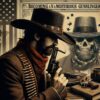Western Legends: Living the Life of a Cowboy
The American West, often celebrated as a land of adventure and untamed landscapes, is synonymous with the cowboy—the quintessential figure of frontier life. “Western Legends: Living the Life of a Cowboy” explores the rich tapestry of cowboy culture and legend, revealing the experiences, values, and challenges that defined this iconic role. Cowboys, with their distinctive hats, rugged demeanor, and connection to the open range, have come to symbolize the spirit of the Wild West. This exploration delves into the everyday life of a cowboy, the historical evolution of the cowboy legend, and the enduring appeal of this symbol in American culture.

Part 1: The Daily Life of a Cowboy
The Cowboy’s Routine
The daily life of a cowboy was shaped by the demands of cattle ranching and the vast expanses of the American West. Early mornings were typical, beginning before sunrise to tend to the needs of livestock and prepare for the day’s work. Cowboys spent much of their time on horseback, herding cattle, repairing fences, and performing other tasks essential to ranch life. The work was physically demanding and required a combination of skill, endurance, and resilience. Daily routines were marked by a strong sense of duty and responsibility, reflecting the cowboy’s commitment to the land and their livelihood.
Life on the Range
Living on the range presented unique challenges and experiences. Cowboys often worked long hours in harsh conditions, with weather ranging from scorching heat to biting cold. Their homes were typically modest, including simple cabins or tent setups that provided basic shelter. Meals were often hearty but simple, consisting of staples such as beans, meat, and cornbread. Despite the rugged conditions, life on the range fostered a strong sense of camaraderie among cowboys, who relied on each other for support and companionship. The lifestyle of a cowboy on the range was a blend of hard work, isolation, and community, shaped by the demands of frontier life.
Cowboy Skills and Equipment
To thrive in the challenging environment of the Wild West, cowboys developed a range of specialized skills and utilized various pieces of equipment. Riding skills were essential, as cowboys spent much of their time on horseback, navigating diverse terrains and managing cattle. Roping and branding were critical skills for handling livestock, while knowledge of cattle behavior and trail management was vital for successful ranching. Cowboys also relied on durable equipment, including saddles, boots, and spurs, to perform their duties effectively. Mastery of these skills and equipment was fundamental to the cowboy’s role and contributed to their legendary status.
Part 2: The Evolution of the Cowboy Legend
The Historical Origins
The legend of the cowboy has roots in the early cattle ranching days of the American West. Spanish and Mexican vaqueros, who managed cattle and worked on ranches in the Southwest, provided the foundation for many cowboy traditions. As settlers moved westward, they adopted and adapted these practices, blending them with their own cultural influences to create the cowboy archetype. The cowboy legend evolved over time, shaped by historical events, economic changes, and cultural influences, becoming a symbol of the American frontier and its values.
The Cowboy in Literature and Film
The image of the cowboy has been significantly shaped by literature and film, contributing to the enduring legend of the American West. Early Western novels and dime novels romanticized the cowboy’s adventures, portraying them as heroes and symbols of rugged individualism. The cinematic portrayal of cowboys in Western films further cemented their iconic status, with actors such as John Wayne and Clint Eastwood embodying the qualities of bravery, honor, and toughness. These portrayals contributed to the creation of a larger-than-life cowboy persona, blending fact and fiction to shape the public’s perception of the American West.
The Impact of Western Culture
Western culture, including rodeos, cowboy music, and traditional events, has played a significant role in maintaining and celebrating the cowboy legend. Rodeos, which originated as competitive events showcasing cowboy skills, have become a popular form of entertainment and a way to honor cowboy traditions. Cowboy music and songs, often reflecting themes of adventure, love, and hardship, contribute to the cultural identity of the cowboy. These cultural elements help to perpetuate the cowboy legend and keep the spirit of the Wild West alive in contemporary society.
Part 3: The Realities of Cowboy Life
Economic and Social Challenges
While the cowboy legend is often associated with adventure and heroism, the reality of cowboy life included significant economic and social challenges. Cattle ranching was a difficult and sometimes unprofitable endeavor, with fluctuating market prices and the constant need for maintenance and labor. Cowboys often faced financial hardships, including low wages and the occasional lack of resources. Socially, cowboys were sometimes viewed with suspicion or prejudice, especially as they were often transient workers who moved from place to place. These challenges highlight the contrast between the romanticized image of the cowboy and the realities of their everyday lives.
The Cowboy’s Role in Society
Despite the challenges, cowboys played a crucial role in the development of the American West. Their work in cattle ranching helped to establish important economic and social structures in frontier towns and rural areas. Cowboys also contributed to the creation of a distinctive Western culture, influencing everything from fashion to language. Their role in society was multifaceted, encompassing both the practical aspects of ranching and the cultural significance of their image. The cowboy’s contributions to society reflect their importance in shaping the history and identity of the American West.
Modern Cowboys and the Legacy of the Old West
The legacy of the cowboy continues to influence modern ranching and rural life. Contemporary cowboys often maintain traditional skills and practices while adapting to modern technologies and changing economic conditions. Rodeos and Western events remain popular, preserving the cultural heritage of the cowboy and celebrating their contributions to American history. The modern cowboy embodies a blend of old and new, honoring the traditions of the past while navigating the complexities of the present. This continuity highlights the enduring impact of the cowboy legend and its relevance in contemporary society.
Part 4: The Enduring Appeal of the Cowboy Legend
The Cowboy’s Symbolism
The cowboy symbolizes a range of qualities and values that continue to resonate with people today. Traits such as independence, bravery, and a strong work ethic are associated with the cowboy image and contribute to its enduring appeal. The cowboy represents a spirit of adventure and resilience, embodying the ideals of the American frontier. This symbolism extends beyond historical and cultural contexts, influencing modern perceptions of heroism and personal integrity.
Cowboy Culture in Contemporary Media
The cowboy remains a prominent figure in contemporary media, with films, television shows, and literature continuing to explore and celebrate the cowboy legend. Modern Westerns and historical dramas often feature cowboys as central characters, reflecting both traditional and contemporary aspects of their role. The portrayal of cowboys in media serves to perpetuate their iconic status and keep the legend alive for new generations. This continued presence in media highlights the cowboy’s lasting impact on American culture and the ongoing fascination with the Wild West.
The Legacy of Cowboy Values
The values associated with cowboys, such as hard work, loyalty, and self-reliance, continue to influence American culture and identity. These values are often celebrated in various forms of media and cultural events, reinforcing the importance of the cowboy’s legacy. The legacy of cowboy values extends beyond historical and cultural contexts, shaping modern perspectives on character and conduct. This enduring influence underscores the significance of the cowboy legend and its relevance to contemporary society.
The Future of Cowboy Culture
As society evolves, the future of cowboy culture will likely continue to blend tradition with innovation. New generations of cowboys and ranchers will carry forward the legacy of the Old West while adapting to changing circumstances and technologies. The preservation of cowboy traditions and the celebration of Western heritage will remain important in maintaining the connection to the past. The future of cowboy culture will be characterized by a dynamic interplay between honoring historical legacies and embracing contemporary developments.
Conclusion
“Western Legends: Living the Life of a Cowboy” provides a comprehensive exploration of the cowboy’s role in American history and culture. By examining the daily life of cowboys, the evolution of their legend, and the realities of their existence, this exploration reveals the complexities and enduring appeal of the cowboy figure. The legacy of the cowboy continues to shape cultural perceptions and values, reflecting a spirit of adventure and resilience that resonates across time.
The enduring fascination with the cowboy legend highlights the significant impact of this iconic figure on American identity and culture. Through media representations, cultural celebrations, and the continuation of cowboy traditions, the spirit of the Wild West remains alive and relevant. The story of the cowboy serves as a testament to the enduring allure of the American frontier and the values that define the legacy of the Old West.


